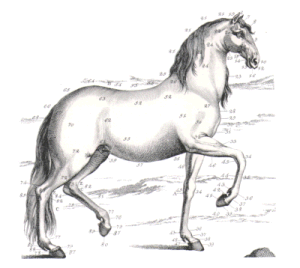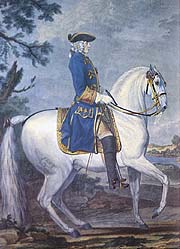The Lusitano
This page is about the Lusitano breed and some of it's history. I'm no expert. This page is my opinion and things I have picked up in my search, of understanding the Lusitano breed.
I have lots to learn, but someday I hope to be breeding and riding, puro sangue Lusitano horses.
Enjoy!
In the early part of this
century, the original Iberian horse
was divided in the two horse breed, now known as the Spanish: Pura Raza
Española/P.R.E. (Andalusian ) and the Portuguese: Puro Sangue Lusitano.
Lusitano means Portuguese in old-Latin, the old name for Portugal was and
still is: Lusitania.
The Iberian horse is the oldest saddle horse in the world.
They have been ridden in over 5000 years and used as war horses. But you
can read about the history of the Lusitano, several places on the web,
I'm no expert so I recommend you to read about them, here: LINKS!
 |
I want to tell about my own knowledge of the
Lusitano,
what I think, like and know. I was introduced to the "Luso" in 1996 after
being introduced to the breed, through the web. I came in contact with
the president of the International Andalusian and Lusitano Horse Association (IALHA), Dr. William (Bill)
Killingsworth. He told me, that the best way
to know more about the breed, was to see them in real life, in Portugal
- and so I did!
My favorite was the d'Andrade brand, that is one of the biggest and oldest breeding lines in Portugal Dr. Ruy d'Andrade started with his brand, then several of his family members have become breeders as well with their own brands. The d'Andrade line has a calm and very soft temperament, they look more refined and often with a straight profile and a powerful neck line. they are mostly used for artistic, competitive dressage and traditional Portuguese Equition. After seeing lusitano foals, fillies, colts, mares and stunning stallions, all other horse breeds, just didn't look right. Suddenly I hated the typical Danish Warm blood type, with it's long neck and back. I just think now that the way the Iberian horse is built, is the correct way. It's logical for balance and power in the movements. |
From the APSL - Associacäo Portuguesa de Criadores do Cavalo Puro Sangue Lusitano, here are the standard measurements and requirements for the Puro Sangue Lusitano:
| 1. TYPE: | Middleweight (weight around 500 Kgs.) "Medium lined"; sub convex profile throughout the body (with rounded outlines the silhouette of which can be fitted into a square). |
| 2. HEIGHT: | Medium, to be measured at the withers with a measuring stick at the age of 6 years. Average Height Females 1.55 m (nearest 15.1 h.h.); Males - 1.60 m (15.3 h.h.). |
| 3. COAT: | The most appreciated and esteemed are all shades of grey and bay. |
| 4. TEMPERAMENT: | Noble, generous and ardent, but always gentle and able to support duress. |
| 5. MOVEMENTS: | Agile, elevated forward, smooth and having a great facility to carry the rider in con fort. |
| 6. APTITUDE: | A natural ability for concentration, with a great disposition for High School work and courage and enthusiasm for the gineta exercises (combat, hunting, bullfighting, work with cattle, etc.). |
| 7. HEAD: | Well proportioned, of medium length, narrow and dry: with the lower jaw not too pronounced and the cheek inclined to be long. Slightly sub-convex profile with the forehead in advance of the bones of the eyebrows: the eyes beneath tend to be elliptical in shape (almond shaped), big and alive, expressive and confident. The ears are of the medium length, fine, narrow and expressive. |
| 8. NECK: | Of medium length, arched with a narrow hairline: the junction between head and neck is narrow or fine: the neck is deep in the base and well inserted between the shoulders, rising up from the withers without any convexity. |
| 9. WITHERS: | Well defined and long, with a smooth transition from the back to the neck. Always higher than the croup. |
| 10. CHEST: | Of medium size, deep and muscular. |
| 11. RIBCAGE: | Well developed, long and deep with the ribs obliquely arched into the join with the spinal column which promotes a short and full flank. |
| 12. SHOULDERS: | Long, slanting and well muscled. |
| 13. BACK: | Well defined and tending towards the horizontal making a smooth union between the withers and loins. |
| 14. LOINS: | Short, wide, muscular, slightly convex, well connected with the back and croup with which they form a continuous harmonious line. |
| 15. CROUP: | Strong and rounded, well balanced, slightly slanting, the length and width should be of identical proportions, the profile convex and harmonious with the point of hip relatively unobtrusive, giving the croup a transverse section of elliptical shape. The tail emerges from the same line as the croup, being of long, silky and abundant hair. |
| 16. LEGS: | The forelegs are well muscled, and harmoniously
inclined.
The upper arm straight and muscular. The cannons slightly and muscular. The fetlocks are dry, relatively big and with very little hair. The pasterns are relatively long and sloping. The hooves are of good constitution, well defined and proportioned without being too open; the line of the coronet is not very evident. The buttock is short and convex. The thigh is muscular and tends to be a short, and it orientated in such a way that the patella or gas kin is in the same vertical line as the hip bone, or point of the hip. The legs is slightly long from hock which puts the point of the hock in the same vertical line as the point of the buttock. The hocks are large, strong and dry. The back legs present a picture of relatively closed angles. |
Score:
| Dansk | Engelsk | Portugisisk | |
| Hoved og hals | Head & Neck | Cabeça e pescoço | 1,0
|
| Skulder og manke | Shoulder & Withers | Espádua e garrote | 1,0
|
| Bringe og brystkasse | Chest & Ribcage | Peitoral e costado | 1,0
|
| Ryg og lænd | Back & Loins | Dorso e rim | 1,5
|
| Kryds | Croup | Garupa | 1,0
|
| ben | Legs | Membros | 1,5
|
| Sammensætning/helhed | Set of forms | Conjunto de formas | 1,5
|
| Bevægelser og gang | Movements & Gaits | Andamentos | 1,5
|
| Total: | 10
|
The colors are 59% grey, 25% bay, 5% black, 3%
chestnut
and 4% other colors like: isabela, palomino, albino and white.
(Relative frequency of the pelagens registadas in
stud-book of the Lusitano, for a total of 13883 animals).
 |
Todays Lusitano is bred for competitions and pleasing
confirmation.
The explanation to the question of why no one has heard that much about
the Luso, can be the small number of breeding Lusitanos. Portugal has the
largest number of Luso stud farms, then Brazil, France, Belgium, Germany
and USA. In Denmark where I live, we only have about 3 maybe 4 Lusitanos
(I know of).
The breeders of Lusitano horses, have always bred for
performance, the different line of horses, where bred for different purposes.
Some where bred for the bullfighting arena, others for the Portuguese
classical dressage and so on.
|
|
Your contact ind Denmark Eva Ørndrup |